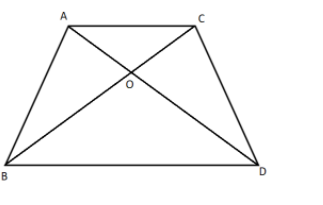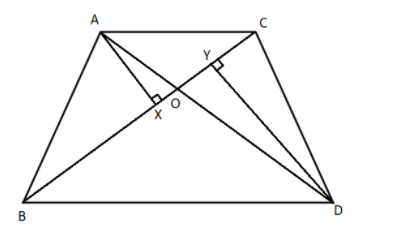
ABC and DBC are two triangles on the same base BC. If AD intersects BC at O, show that
\[\dfrac{{ar\left( {ABC} \right)}}{{ar\left( {DBC} \right)}} = \dfrac{{AO}}{{DO}}\]


Answer
455.4k+ views
Hint: Here we will first draw the perpendiculars on the base BC from the point A and point D. Then we will show the triangles similar to get the relation between the perpendiculars and the sides AO and DO. Then we will find the ratio of the area of the required triangles and use the obtained relation to get the desired equation.
Formula Used:
We will use the formula Area of the triangle \[ = \dfrac{1}{2} \times {\rm{Base}} \times {\rm{Height}}\].
Complete step-by-step answer:
First, we will construct a perpendicular AX on the base BC and a perpendicular DY on the base BC. Therefore, we get

Now we will take the triangles AXO and triangle DYO and we will show that it’s the similar triangles. Therefore, we get
In \[\Delta AXO\] and \[\Delta DYO\],
$\Rightarrow$ \[\angle AXO = \angle DYO = 90^\circ \]
And
$\Rightarrow$ \[\angle AOX = \angle DOY\] because these are the vertical opposite angles.
Hence, by the rule of Angle-Angle (AA) similarity rule we can say that the triangles AXO is similar to the triangle DYO i.e. \[\Delta AXO \approx \Delta DYO\].
As these triangles are similar then the corresponding sides of the similar triangles are always proportional to each other. Therefore, we get
$\Rightarrow$ \[\dfrac{{AX}}{{DY}} = \dfrac{{XO}}{{YO}} = \dfrac{{AO}}{{DO}}\]……………………….\[\left( 1 \right)\]
Now we will find the ratio of the area of the triangle ABC to the area of the triangle DBC. Therefore, we get
$\Rightarrow$ \[\dfrac{{ar\left( {ABC} \right)}}{{ar\left( {DBC} \right)}} = \dfrac{{\dfrac{1}{2} \times BC \times AX}}{{\dfrac{1}{2} \times BC \times DY}} = \dfrac{{AX}}{{DY}}\]
By using the equation \[\left( 1 \right)\] in the above equation, we get
\[ \Rightarrow \dfrac{{ar\left( {ABC} \right)}}{{ar\left( {DBC} \right)}} = \dfrac{{AO}}{{DO}}\]
Hence proved.
Note: Triangle is a two-dimensional geometric shape that has three sides. There are different types of triangles such as isosceles triangle, equilateral triangle, right angled triangle, etc. Similar triangles are triangles that have an exact similar shape but the size of the triangles may vary. We should note that the area of the triangle is equal to half the product of the base of the triangle and the height of the triangle.
Also, the Angle-Angle (AA) similarity rule states that if in two triangles, two pairs of corresponding angles are same or equal, then the triangles are said to be similar triangles.
Formula Used:
We will use the formula Area of the triangle \[ = \dfrac{1}{2} \times {\rm{Base}} \times {\rm{Height}}\].
Complete step-by-step answer:
First, we will construct a perpendicular AX on the base BC and a perpendicular DY on the base BC. Therefore, we get

Now we will take the triangles AXO and triangle DYO and we will show that it’s the similar triangles. Therefore, we get
In \[\Delta AXO\] and \[\Delta DYO\],
$\Rightarrow$ \[\angle AXO = \angle DYO = 90^\circ \]
And
$\Rightarrow$ \[\angle AOX = \angle DOY\] because these are the vertical opposite angles.
Hence, by the rule of Angle-Angle (AA) similarity rule we can say that the triangles AXO is similar to the triangle DYO i.e. \[\Delta AXO \approx \Delta DYO\].
As these triangles are similar then the corresponding sides of the similar triangles are always proportional to each other. Therefore, we get
$\Rightarrow$ \[\dfrac{{AX}}{{DY}} = \dfrac{{XO}}{{YO}} = \dfrac{{AO}}{{DO}}\]……………………….\[\left( 1 \right)\]
Now we will find the ratio of the area of the triangle ABC to the area of the triangle DBC. Therefore, we get
$\Rightarrow$ \[\dfrac{{ar\left( {ABC} \right)}}{{ar\left( {DBC} \right)}} = \dfrac{{\dfrac{1}{2} \times BC \times AX}}{{\dfrac{1}{2} \times BC \times DY}} = \dfrac{{AX}}{{DY}}\]
By using the equation \[\left( 1 \right)\] in the above equation, we get
\[ \Rightarrow \dfrac{{ar\left( {ABC} \right)}}{{ar\left( {DBC} \right)}} = \dfrac{{AO}}{{DO}}\]
Hence proved.
Note: Triangle is a two-dimensional geometric shape that has three sides. There are different types of triangles such as isosceles triangle, equilateral triangle, right angled triangle, etc. Similar triangles are triangles that have an exact similar shape but the size of the triangles may vary. We should note that the area of the triangle is equal to half the product of the base of the triangle and the height of the triangle.
Also, the Angle-Angle (AA) similarity rule states that if in two triangles, two pairs of corresponding angles are same or equal, then the triangles are said to be similar triangles.
Recently Updated Pages
Glucose when reduced with HI and red Phosphorus gives class 11 chemistry CBSE

The highest possible oxidation states of Uranium and class 11 chemistry CBSE

Find the value of x if the mode of the following data class 11 maths CBSE

Which of the following can be used in the Friedel Crafts class 11 chemistry CBSE

A sphere of mass 40 kg is attracted by a second sphere class 11 physics CBSE

Statement I Reactivity of aluminium decreases when class 11 chemistry CBSE

Trending doubts
When people say No pun intended what does that mea class 8 english CBSE

In Indian rupees 1 trillion is equal to how many c class 8 maths CBSE

How many ounces are in 500 mL class 8 maths CBSE

Which king started the organization of the Kumbh fair class 8 social science CBSE

What is BLO What is the full form of BLO class 8 social science CBSE

Advantages and disadvantages of science




